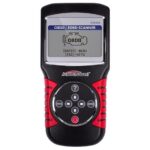A vehicle’s On-board Diagnostics system (OBDII) monitors various components, including the transmission. When a problem is detected, the Malfunction Indicator Lamp (MIL) illuminates, and a Diagnostic Trouble Code (DTC) is stored. Transmission-related DTCs can indicate a range of issues, potentially leading to increased emissions and drivability concerns. This poster provides information on transmission DTCs, their potential causes, and the repair process.
Common Causes of Transmission DTCs
Transmission DTCs can stem from various malfunctions within the transmission system. These include:
- Torque Converter Clutch (TCC) Issues: Problems with the TCC, which locks the engine and transmission together at higher speeds for improved fuel efficiency, can trigger a DTC.
- Shift Solenoid Malfunctions: Faulty shift solenoids, responsible for controlling fluid flow and gear changes, can disrupt proper transmission operation and set a DTC.
- Transmission Speed Sensor Problems: Inaccurate readings from the transmission speed sensor can lead to improper shifting and a DTC. While this is often a less expensive repair (potentially under $600) compared to internal transmission issues which can range from $1500 to $3000, it’s crucial to have it diagnosed properly.
- Fluid and Filter Issues: Contaminated or low transmission fluid can cause slippage and other problems, leading to a DTC. Sometimes, a simple fluid and filter change can resolve the issue.
Diagnosing and Repairing Transmission DTCs
Diagnosing transmission DTCs requires specialized equipment and expertise. A Recognized Emissions Repair Facility (RERF) or a dealership can accurately pinpoint the problem using OBDII scanners and other diagnostic tools. They will check all electrical circuits and components to identify the root cause.
Repairing transmission problems can be costly, often exceeding $600. The complexity of the repair, often requiring transmission removal, contributes to the high cost. In some cases, if the repair cost is deemed unreasonable, a waiver may be available. Contact your local Department of Public Safety (DPS) Waiver Station for more information. Remember to bring a repair receipt from a RERF or dealership outlining the diagnosis and cost estimate to qualify for a waiver.
Engine-Related DTCs and Transmission Problems
It’s important to note that engine-related problems can also affect transmission performance. For instance, an engine misfire can set a DTC and cause shifting issues. Therefore, a comprehensive diagnosis is crucial to differentiate between engine and transmission problems. The RERF or dealer will be able to determine if the transmission issue is the primary problem or a symptom of a separate engine malfunction.
The Importance of Addressing Transmission DTCs
Addressing transmission DTCs is essential for maintaining vehicle emissions compliance and ensuring proper drivability. While a minor transmission slip might not initially seem concerning, ignoring it can lead to more significant and costly damage over time. Prompt diagnosis and repair can prevent further problems and ensure the vehicle operates efficiently and safely. A malfunctioning transmission, as part of the vehicle’s powertrain, directly impacts emissions and can cause a vehicle to fail emissions tests.

